A complete redesign of Honda’s Gold Wing was unveiled to the press earlier today in Santa Barbara, California. Honda says the new Gold Wing is lighter (by approximately 90 pounds) and sportier. The engine is still an 1833cc flat six, but now it has four valves per cylinder.
As we expected, Honda’s DCT automatic transmission is available or, should you choose, a traditional six-speed manual transmission is offered. A large TFT display is compatible with Apple CarPlay (for those of you with iPhones). A unique double-wishbone front suspension system is found on all models, along with electric windscreen adjustment.
Here are all the details from Honda:
– SANTA BARBARA, Calif. The next chapter in one of Honda’s most storied narratives began today with the unveiling of the 2018 Gold Wing and Gold Wing Tour models. Revealed during a special event at Santa Barbara, California’s MOXI Museum of Exploration and Innovation, the all-new Gold Wing takes cues from the legendary GL models that came before it while maximizing potential through a lighter, more thrilling, and more technologically advanced package with a new engine, chassis, and electronics suite.
“It’s a great feeling to pull the wraps off the all-new Gold Wing and Gold Wing Tour models here in Santa Barbara, a scenic town that itself strikes a balance between its celebrated history and modern flare,” said Chuck Boderman, Vice President of American Honda’s Motorcycle Division. “The impact of the GL line on the motorcycling world can be seen in the community that has formed around it, and we believe that in this latest version, Honda has produced a motorcycle that will be embraced by not only the existing Gold Wing community, but a fresh generation of riders seeking strong handling performance along with long-distance touring capabilities. Lighter, more agile, and more sophisticated, the 2018 Gold Wing and Gold Wing Tour set a new standard for the touring category, with groundbreaking features that enhance the riding experience and encourage riders to get out on the road, creating more exciting stories than ever before.”
ENGINE
Honda’s liquid-cooled, horizontally opposed six-cylinder engine is a key element to the Gold Wing’s rich character, and while the general layout lives on, much has been done to make the powerplant more compact, more fuel efficient, and lighter. The engine is now 13.7 lbs. lighter when equipped with Honda’s six-speed manual transmission, and 29mm shorter in the front section, and is placed forward in the chassis for more ideal weight distribution, a key contributor to the 2018 Gold Wing’s sporty handling and improved vehicle packaging.
Specific changes for 2018 include a smaller, 73mm cylinder bore, updated crankshaft, and a Unicam® valve train layout that has been proven on the award-winning Honda CRF450R motocrosser. Combustion efficiency is improved via the use of four valves per cylinder, while friction is reduced through the application of a new molybdenum coating on the piston skirts. Thanks to a lighter overall package and enhanced vehicle aerodynamics, which led to improved fuel efficiency, engineers were able to reduce the fuel tank capacity by 1.1 gallons while retaining the same great range as before. This change is one of many aimed at improving handling via refined vehicle packaging and weight reduction.
Additional changes include a new intake system for added responsiveness and torque, as well as an updated exhaust system that highlights the bike’s livelier personality through a deeper exhaust note.
TRANSMISSION
The Gold Wing and Gold Wing Tour are available with both a new six-speed manual transmission or Honda’s advanced, next-generation seven-speed automatic Dual Clutch Transmission (DCT), which includes forward/reverse Walking Mode.
CHASSIS AND SUSPENSION
For 2018, the Gold Wing chassis has undergone multiple revisions to increase low-speed maneuverability and maintain high-speed stability. A robotically welded twin-spar aluminum frame uses plates with reconfigured thicknesses and is matched to a single-sided swingarm with new pivot-area structure. Together, the frame and swingarm contribute to a 4.4 lb. weight reduction, which when combined with the low center of gravity and better mass centralization, contributes significantly to the bike’s improved nimbleness.
Suspension is comprised of a new double-wishbone front-suspension system and Showa shock absorbers front and rear. Designed to offer reduced friction and less inertial mass for the front-end components that are manipulated via the handlebars, the system also leads to more compact vehicle dimensions, as its different stroke trajectory enabled engineers to position the engine closer to the front wheel. For added comfort, the Gold Wing uses a Pro-Link® rear-suspension configuration with progressive reaction. On most models, suspension damping and preload are electrically adjusted.
Brakes have been upgraded via radially mounted front calipers and larger, 320mm rotors. Electronically controlled combined ABS works to distribute braking force to the front and rear wheels while saving weight through the use of a smaller, lighter circulation-type ABS modulator.
ELECTRONICS
Fully modern, the 2018 Gold Wing features a throttle-by-wire system that has opened the door to four riding modes (Tour, Sport, Econ, and Rain), Honda Selectable Torque Control (HSTC), Hill Start Assist, and a finely tuned cruise-control system. Selecting the riding mode that’s best suited for the riding conditions is easily accomplished through the Gold Wing’s new controls, and then confirmed via a beautiful, 7-inch full-color Thin Film Transistor liquid-crystal display—one of the many features that bolster the model’s premium feel.
In an industry first, the 2018 Gold Wing also comes equipped with Apple CarPlay™, which connects the motorcycle to the user’s iPhone to show maps, contacts, and music, all accessed through the motorcycle’s display.
DESIGN
The sportier nature of the 2018 Gold Wing and Gold Wing Tour is underlined by the bike’s sharper, more performance-minded shape, which also achieves a significant boost in aerodynamic efficiency. Narrower at the front and with added emphasis on such mechanical parts as the exhaust and lower engine, the bike offers the same comfortable ergonomics as before, but with reimagined airflow for rider and passenger, both of whom sit 36mm further forward. Thanks to new air-guiding ducts and an electric windscreen that provides the rider with even greater control over airflow, it is now more possible to feel at one with the elements, or to enjoy a windless-type experience.
LED technology is used throughout, with the multiple-lens front lights forming the new “wing lines” of this latest advanced performance touring model, and the LED turn signals having a convenient auto-canceling feature. A user-friendly luggage system bolsters on-road convenience while also contributing to the vehicle’s compact dimensions, sporty appearance, and lighter weight. Each saddlebag holds 30 liters, while the top case has a 50 liter capacity, and high-quality lid dampers are used throughout.
KEY UPDATES
- Lighter overall package results in improved handling and maneuverability
- More compact, lighter engine with four-valve head and Unicam valve train
- Available seven-speed DCT with Walking Mode forward/reverse
- Six-speed manual transmission
- Robotically welded aluminum twin-tube frame with revised plate thicknesses
- Radially mounted six-piston dual front braking calipers
- Double-wishbone front-suspension system
- Electrically controlled suspension
- Throttle-by-wire with multiple riding modes
- Honda Selectable Torque Control (HSTC)
- Hill Start Assist
- Smart Key
- Apple CarPlay compatibility
- LED lighting
- Updated design with 11.8 percent improved aerodynamic efficiency
- Electric windscreen adjustment
GOLD WING TOUR
The three 2018 Gold Wing Tour models—Gold Wing Tour, Gold Wing Tour DCT, and Gold Wing Tour DCT Airbag—are the modern interpretation of the classic Gold Wing, the ultimate long-distance touring machine, but with highly improved performance capabilities. Each of these models features saddlebags and a top case, as well as a tall electrically adjustable windscreen, front and rear speakers, and electrically adjustable suspension.
- Colors
- Gold Wing Tour, Gold Wing Tour DCT: Candy Ardent Red, Pearl White, Pearl Hawkseye Blue
- Gold Wing Tour DCT Airbag: Candy Ardent Red/Black
- Price
- Gold Wing Tour: $26,700 – $27,200
- Gold Wing Tour DCT: $27,700 – $28,200
- Gold Wing Tour DCT Airbag: $31,500
- Availability: February 2018
GOLD WING
Boasting a sporty character, the two Gold Wing models—Gold Wing and Gold Wing DCT—come with saddlebags but no top case or the accompanying rear audio speakers. The electric windscreen is shorter on these models, and preload adjustment is manual. HSTC, electric damping-adjust, center stand, and heated grips are not included.
- Colors: Candy Ardent Red, Matte Majestic Silver, Pearl Stallion Brown
- Price
- Gold Wing: $23,500 – $23,800
- Gold Wing DCT: $24,700 – $25,000
- Availability: February 2018
See more of MD’s great photography:
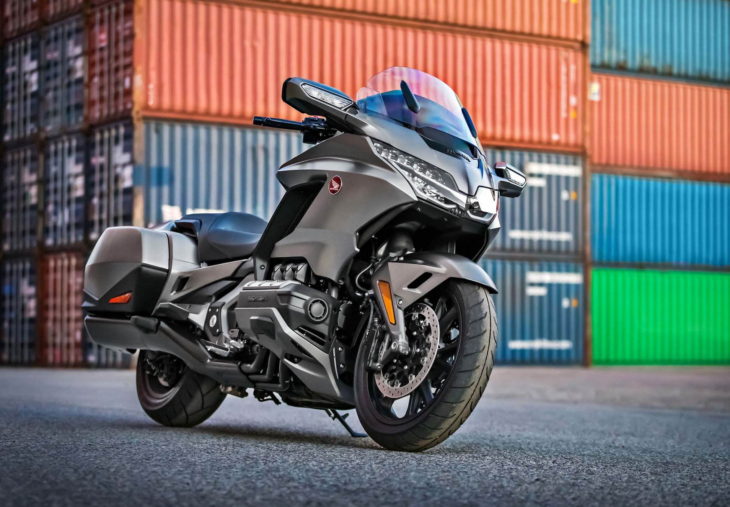
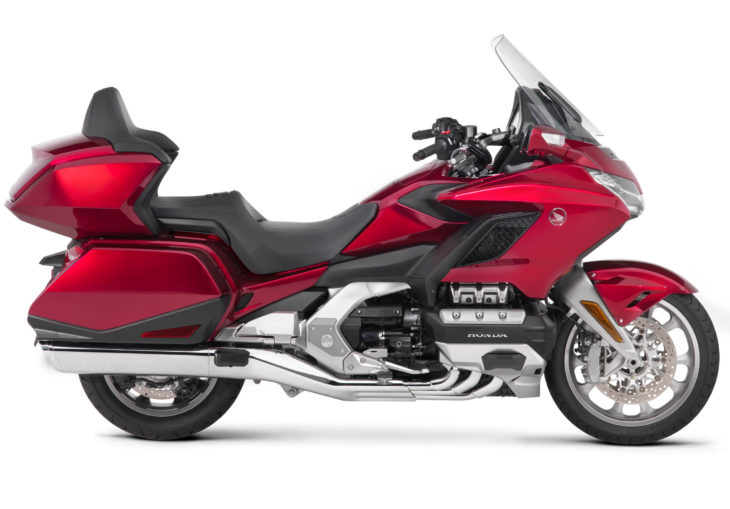
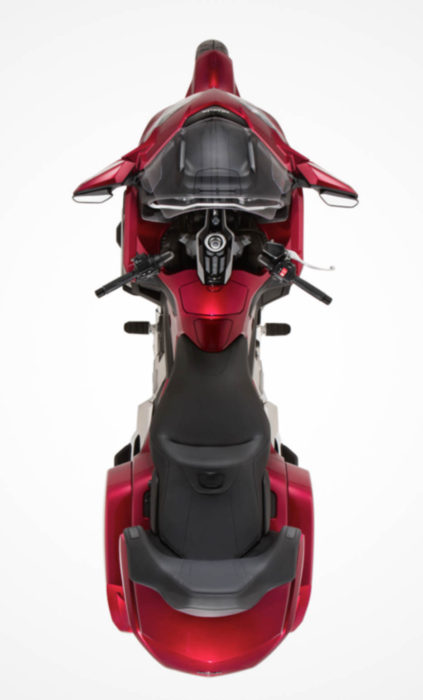

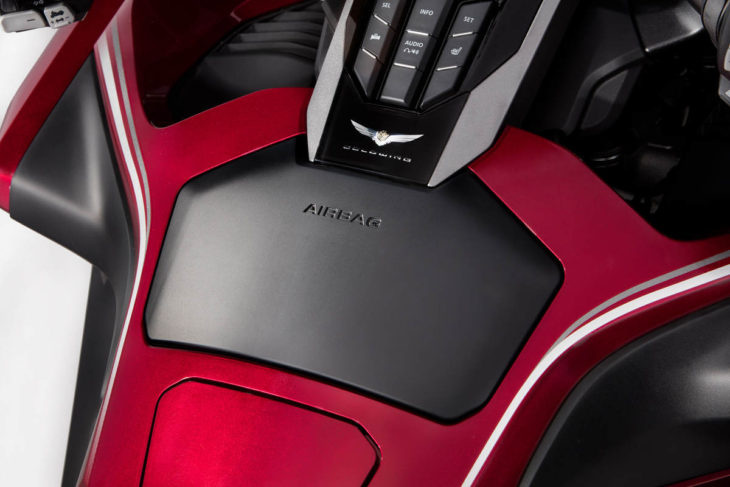
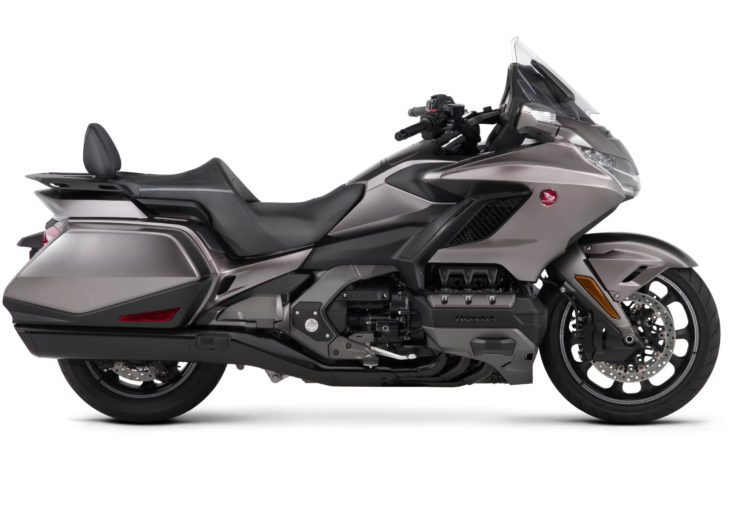
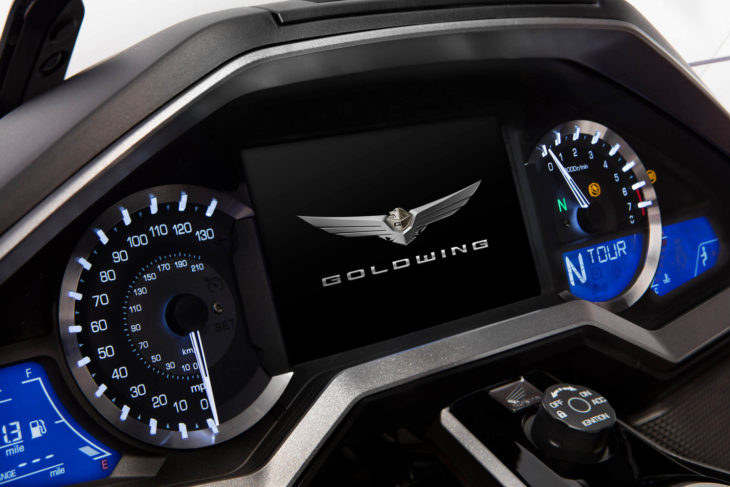
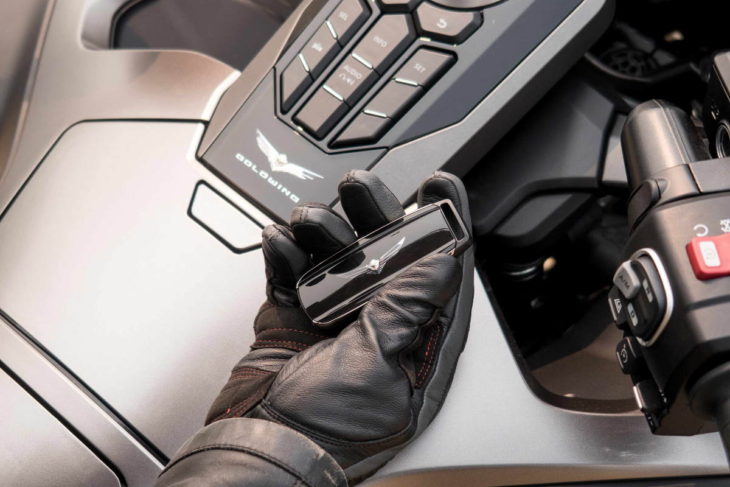
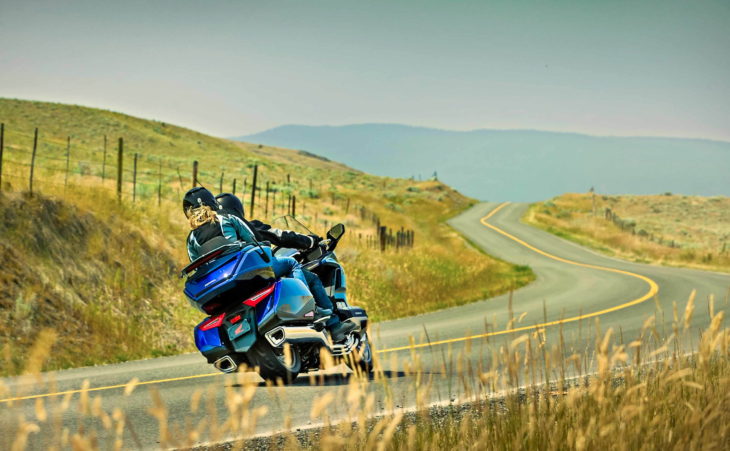






The most interesting aspect of the new Goldwing is the front suspension. It is Hossack-like and will be compared to Duolever, but the departures from what has previously been done appear significant.
Like Duolover and any Hossack-like front suspension, the basic idea is the parallel arm arrangement to couple the weight between the fork and the main chassis. With Hossack and Duolever, no ordinary steering bearing is used, i.e., no bearing like what is used in a conventional dual-fork arrangement. Rather, the two wishbones have ball joints at their front tips, where they join to the upper part of the fork. Steering is provided by placing a more ordinary steering bearing above and directly in line with the nominal steering axis (which changes slightly as the suspension moves up and down), using this bearing to support the handlebar, then using a simple scissor arrangement to couple the steering action between the fork and the handlebar steering bearing located in line with the nominal steering axis of the fork.
Recently, MotoCzysz did something different, but I don’t know what it was exactly, so I don’t whether Honda’s new front suspension has any strong similarity to what MotoCzysz did. In Honda’s approach, the ball joints at the fore end of the wishbones are replaced with simple pivot joints, i.e., roller bearing joints, which do not accommodate steering rotation. Steering rotation is accommodated with the help of a big bearing, not at all different from the steering bearing you find in a dual-fork setup. There is an outer sleeve-like casing around this bearing; the simple pivot joints for the wishbone are rigidly integrated with the outer casing. For the upper wishbone, the simple pivot is located in front of the outer casing of the steering bearing; the fork passes through the interior of the wishbone. This is something that you obviously can’t do with the ball joint setup, and this feature draws attention to the difference between the two approaches. As with Duolever, a coil-over shock is mounted to the lower wishbone.
Honda’s departure from Duolever is even more pronounced when you look at how steering action is coupled between the fork and the handlebar. Instead of placing the handlebar steering pivot above the fork and with axis in line with the nominal (non-static) steering axis of the fork, the handlebar steering pivot is offset well aft of the fork steering axis. I favor this approach with a big bike, because when the reach to the steering axis of the fork is especially long, you either have to lean very far forward or else use very long handlebars, and when you use very long handlebars, the steering motion sensed by the rider is a sort of side-to-side swinging motion, which I believe interferes with rider control.
Duolever’s scissor mechanism for coupling steering assumes that the steering pivot of the handlebar is located above the fork and in line with the steering axis of the fork. It is obviously of no use here. Honda’s design appears to use to small linkage arms to couple steering action between the fork and the part of the handlebar that enters the handlebar’s steering bearing. There is one arm on each side.
Honda’s approach with respect to how the wishbones join to the fork does not eliminate the dynamic nature of the fork’s steering axis. It is still a parallelogram arrangement, and as it collapses and expands, the forward edge or side of the parallelogram moves. It moves fore and aft slightly, and the angle changes slightly. Potentially, different geometry will mitigate this effect, but can’t eliminate it. (And it is not immediately apparent whether differences in geometry may have been used to mitigate this effect at all.) This behavior was and is a fundamental problem for Duolever. Honda had to accommodate the same effect, in their coupling of steering action between a dynamic steering axis (the fork) and a static steering axis (the bearing that supports the handlebar).
The most important question, concerning the possible advantages of Honda’s approach vs. Duolever, is likely going to be whether Honda’s approach in the coupling of steering action, between the dynamic steering axis of the fork and the static steering axis of the handlebar, has dealt with this inherent problem in a way that achieves an improvement in steering feel, i.e., precision in steering feedback. The offset of the handlebar steering axis to the rear has the independent advantage of eliminating the swinging effect in the handlebar movement. For the very large motorcycle that the Goldwing is, there will likely be strong consensus that this alone is a major improvement. However, the big unknown is with the precision of steering feedback, where the differences vs. Duolever are likely going to be attributable directly to the difference in the method of coupling the non-static steering axis with the static steering axis.
Forget the reduced tank size, what will have the Hondabago buyers up in arms is the reduction in storage to 110L from 145. Otherwise, nice bike.
The only thing it’s missing is a gallon of fuel!
Engine guards front and rear are still there,they are hidden under the plastic covers. fuel range is the same as the old. Light is right!
Sorry but I really don’t understand this type of bikes. If someone like all those luxuries and amenities, why don’t get a car instead a mammoth on two wheels ?
Ride one and report back. You’ll see.
Pretty sure I’ve if seen this rhetorical question asked before, and the similar rhetorical questions you can apply to any particular type of bike. I’m reasonably certain that there are substantial differences between a Gold Wing and a car, and that everyone including you knows this.
Awesome would seem to be the second most over used word in motorcycle dictum, iconic would be first. So I will start with finally somebody has began to understand the need for weight reduction is as good as an increase in horsepower. I had a 1983 GoldWing Interstate which I piled the miles on with almost no issues. It was heavy by the standards of the day and yet each generation after grew heavier and required larger engines. My much loved GL likely weighed 775 lbs wet and hauled two people without a hitch, handled well, and returned superior fuel mileage.
I can see why Honda ended the ST 1300 platform as this new GoldWing seems to cover both the sport touring bagger and the full boat touring unit all from a related platform. I applaud Honda for stepping out and going with the landing gear front suspension and allowing for two seperate transmissions.
And I was begininng to think things had gotten boring, its going to be a great 2018 model year.
Spot on.
Ten more years before I buy something like this, but it’s approaching. I have seen some folks ride the previous version incredibly quickly, though I’ve seen ’em crash them too. 90 less lbs. helps, though the loss of fuel capacity won’t be popular.
I see a number of things missing that were on the previous model.
Crash bars front and rear, side covers, rear half of front fender are some of the obvious things. No wonder it’s 90 pounds lighter with all the stuff they left off. Combine that with the diminished storage capacity and smaller gas tank this version of the Goldwing is less of a touring machine than the previous model. The claimed improvement in mileage is the same number that I get from my 2004 wing, no real improvement.
So with all that being said, is being 90 pounds lighter a good thing or no?
I don’t think any of those things missing would bother me. Side covers and the rear half of the front fender?
Doesn’t the lighter weight, the adjustable windshield (which I love on my ST 1300) and the 6 speed trans make it a better touring machine?
if you can’t learn to travel with 110 liters of storage, you need to learn to pack better or take less stuff.
The rear part of the front fender is there, just painted black (the wheel is so close to the engine it’s hard to see). The crash bars aren’t there, but there are black plastic/rubber thingies on the same places for tipovers (and probably mounting points if you want to mount lights, highway pegs etc. Now if you tell me your 2004’s range is not enough I´ll want tips on what you do to keep your butt in shape.
Question is, has Marc Marquez ridden the new Wing Yet?
Yes, he barely beat Lorenzo.
Another nice thing….we will probably see a lot of wings go up on the used bike market as folks begin to trade up for one of these new breed beauties.
Well, at 800# it’s only 214# heavier than my ’00 BMW R1150GS. Yeah, I know, apples v. oranges. It’s just a personal reference, the GS being the heaviest bike on which I put a lot of miles (40k in the GS’ case). When I sold the GS I decided to ride only significantly lighter bikes. I still can hardly believe the trek those two GS riders took in the epic movie “Long Way ‘Round.”
Still, though, these new Lead Wings look damn smart, and shall likely own the touring segment for another few decades. The sound of my then-next door neighbor’s early ’00s LW closely mimics that of a modern finely tuned Porsche 911, one of the sexiest sounding motors extant (both are HP flat 6s).
That double wishbone fork has me thinking the CRF 450 & 250 X models are due for a major update perhaps a Ribi Quadrilateral linkage fork will be part of the package.
And maybe a flux capacitor…
Actually just some upgrades like downdraft fuel injection, next generation aluminum frame, twin muffler exhaust system and engine power delivery character mode select button would be fine.
I’m waiting for the Gold Wing Scrambler edition with knobbies and high pipes for the Millennial demographic.
The only thing rarer than a Gold Wing Scrambler, is a millennial that could afford one.
Google “GoldWing dirt bike”…
LOL that was a good laugh, esp. the one with XR 1500R decals.
Great!! Now they FINALLY put the DCT on the Goldwing.
I name it ‘Scootersaurus!’
Now please make a factory trike.
i think i would want the taller screen on the non tour model, but my god it’s 800 pounds
When it comes to Wings my younger self always said “never.” My older, somewhat wiser self, has learned to never say never. Yes, its still a barge in my view. But its a lighter, more stripped down barge. That makes it much more appealing. And its wicked comfortable (there, I said it). Some day … maybe.
Wow. Very nice. The original (1975) Gold Wing was fast – and quite a bit of fun for what it was. Now that I am pushing 57(!), i look at that bagger, and think, hmmmm, maybe it’s time.
Very interesting steering linkage, too.
Harley sales have been dropping – and this isn’t going to help them. After years of Honda weirdness and boredom, they seem to have found their mojo with this one. I hope that this trend continues.
I am very impressed.
+1
I rented a Kia that interfaced with both Apple and Andriod. So I now expect that kind of thing from anything that has that sort of feature.
There is absolutely no way on earth that I would ever spend my money on any Apple product. So having an Apple only interface is a clear invitation for me to ignore any product.
What a difference a few years makes. In 2005, who would’ve believed that all of a vehicle’s mechanical features & benefits would be of secondary importance to whether or not one’s phone of choice could talk to it.
Amen, brother
My bike only connects to my hands, feet and ass…but I have occasionally seen an apple on the road
To each his own. If that’s how you feel, that’s how you feel.
Your soul too. Unless you’re a heathen!
I have been accused a time or two
“There is absolutely no way on earth that I would ever spend my money on any Apple product.”
Wow. You sound bitter.
I would NEVER buy this PS because it won’t connect to my Blackberry ffs!!!! You know you are a cellphone zombie when that is your first priority is whether to buy this bike or not.
Read MGNorge’s comment below. Apparently it’s Google’s fault you can’t chase your Pokemons on a Goldwing, not Honda’s.
You do realize that there will be an app to allow this machine to interface with an android device or a PC.
A reason I ride is to escape cellphones and tech.
Amen!
Great looking bike, but two things jump out at me: The touring model still weighs more than 800 lbs., and fuel capacity is only 5.5 gallons. Granted, it gets better mileage, but …
Honda should have done this years ago. I’ve had Gold Wings for 42 years since my 1976 GL1000 and have had every generation since, and now have a 2015 40 Anniversary Edition. Why Apple Car Play and not Android Auto. There are lot more Android users than iPhone users out there. Apple Car Play is useless with my Samsung Galaxy S8. Also, I don’t like the reduction in fuel tank capacity. I’m not sure about the new fork. Otherwise they hit a home run. I do like that finally, ABS is standard. I wonder what BMW will do now. This puts the K1600GTL to shame.
See my post below. According to Honda, Google did not supply support for Android Auto. My guess is it won’t be long because as you say, there are many more Android users than iPhone.
It’s just as nice as I was hoping for it to be. I was concerned about the possibility of a bigger engine when really it is already a beast of a motor. I’ve had a soft spot for the current generation of GL, but they were still too damn big for me to buy one. I’ve been an FJR guy for over a decade now, but this might actually get me on a Wing if it feels as agile as my FJR. On the other hand, Yamaha might update it and make my decision a lot harder. We are living in the golden age of motorcycling, and I for one am revelling in it!
Excess in every direction, but nice to look at. As a Honda rider I am proud of the brand.
definitely looks better with the studio shots. just have to get used to that rake (it’s a chopper baby). next up, Dirck’s “doppelganger” races the new kit around Motegi, even fancies challenging the Dove on the brakes into Victory corner (hey it’s what the real Dirck would do)…
https://tinyurl.com/yaqowoed
I’m really liking what I’m seeing. It kinda looks like a blend of a GW & a ST1300 in one new sleeker, sportier package. This new GW is def aiming for us gen x’rs whom are now entering our 40’s. In my 17yrs of riding I’ve always told myself I would never own a wing…to big, dated tech, dated sus, manual screen, bars that reach into your lap, but at 42 I could def see myself trading my FJR for this new updated Wing in a few years…maybe for my 50th??? Good job Honda!
Nicely done Honda.
My dear, you look maaaaahvalous!
DAMN!
Really nice! I never thought I’d ride a Wing but who knows? It’s nice to see those three chrome header pipes too.
I thought it interesting that Android Auto wasn’t included since Apple CarPlay is so I did some scrounging and came up with this from cnet.com:
“Yes, you do have to connect a Bluetooth headset, a requirement mandated by Apple, one that is a bit frustrating since most CarPlay interactions don’t require voice. Still, once enabled it works well, controlled either via four-way controller on the left grip or a central, rotary controller down on the tank — though frankly I can’t recommend reaching down to that while on the go. Still, having intelligent navigation and access to your media on the bike is great. I just wish it had Android Auto. (This, I was told, was due to lack of Google support, not an unwillingness on Honda’s part.)”
Not that I care deeply in this support concerning my motorcycles I’m guessing that it could be welcomed by some long distance travelers. My guess is that Android Auto will be included at some point considering the popularity of the format.
90 pounds lighter, that is a great start! more engine showing, and less plastic, bonus for me! I always figured I would someday have to go Goldwing (or some other large barge), but was recently looking to step to a “mid size” sport tour… Maybe just cut it out and jump to the Wing as I keep my bike for decades.
Hmmm.. New smaller Goldwing, or the Kawasaki 900 retro… Apples and Oranges, but they both fruit!
Delicious!
“New smaller Goldwing, or the Kawasaki 900 retro… Apples and Oranges, but they both fruit!
Delicious!”
Great way to put it Dino
What a freaking beautiful bike.
On the mechanical side there are plenty of updates.
The upgrade to 4 valves per cylinder will prove interesting… I wonder if it will result in increased performance.
I see forums with entries: 4 valve cylinder head for older wing.
These are great times to be in the market for a super premium tourer. BMW, Honda, Indian, Harley, and Yamaha all build super expensive tourers that can light anyone’s fire. Apparently, the marketing teams for these brands see a big enough pie to feed all the makes. Best of luck to them.
The only good thing about this for me is the last generation wings prices will go down. I just can’t make myself pay $25 to 30k for a 8 month vehicle.
If I read this correctly, it doesn’t seem to have lean sensitive ABS/TC: which is very surprising if true.
Where is the naked version?
it is, I keep waiting for a naked version as the first goldwing!
Had my fingers crossed the wing wouldn’t grow a foot + 100#. Definitely like this direction they’ve taken. Still have an old GL12, and this new one is back down in that weight class which is excellent. I will have one.
This is what yamaha SHOULD have done with new Venture but they blew it with bloated vtwin barge.
Okay, Yamaha. the GW has lost 90 pounds. The same weight from the FJR would make for a 570 pound bike.
+1. I have a love/hate relationship with FJR. Loving its performance, chassis, etc. hating its weight. 100 lbs less definitely takes out that one side of the equation.
In (yet) another sign that I’m getting old, I’m actually interested in the ‘wing for the first time in my life. This new one anyway.
I remember like it was yesterday, the very first GL1000 in blue with that lift up tank cover. As these things go, this new ‘wing looks a more coherent design than BMW’s big six. That bike seriously needs a DCT!
Knowing Honda as we do, every part will be changed out or altered, but it will feel the same as before. So I hope that for me at least, the standard screen height of the electric hand, has been vastly improved to totally eliminate buffeting.
On my ST1300 when the screen was fully up, the resultant vacuum made it a real issue too. So Mr Honda San, I hope you put your 6’6″ Texan Test Rider on board this project, and left the 5 foot high Jap Test Pilot’s to work on the next Grom.
The Africa Twin has what must be the most ridiculously perfect wind management for it’s screen size of any bike I have ever been on (along with the ZX14R…). As did the S2000 for roadsters, come to think of it… So it does seem Honda has come a long way towards figuring the aerodynamics thing out by now. You do sit further back on the ‘Wing, complicating matters. But the ‘Wing engineers also have a much bigger screen size allowance than their AT counterparts did.
Of course, worse comes to worst, the market for Gold Wing aftermarket screens alone, is bigger than the entire market for most touring bike platforms. So unless you are truly oddly shaped, or prefer riding side saddle or something equally unusual, I can’t imagine a solution for your specific aerodynamic problems not becoming available pronto.
Looks like they nailed it.
While the claimed increased fuel mileage is great, I am absolutely positive that the vast majority of Wing owners will decry the 1.1-gallon reduction in fuel capacity. Those people would have told Honda to leave the capacity alone, or to increase it, while also increasing the fuel mileage.
One thing I didn’t see mentioned in the video or in the specs here is something I saw on another site, which is that the integrated tail box/passenger throne can be deleted from the Gold Wing Tour, or added as an option to the standard Gold Wing.
Lastly, $3,300 (!!) just for the optional airbag, and it can only be included with the Tour DCT version? What if someone wants the six-speed manual Tour, or the standard Gold Wing? Why can’t they still get the airbag?
Just wow. But nearly the same price as an Accord? Still awesome.
Pricey for a motorcycle, but this is the absolute pinnacle of moto technology from Honda (or anyone), comparing to the Accord, which is an excellent car, but still the ubiquitous mid-level sedan.
I am not a touring bike customer, but the move away from the telescoping fork is exciting to me. It’s been too long that the industry has shied away from linkage front ends.
Let’s compare apples to apples. This motorcycle’s technology pales in comparison to the Accord.
NICE, VERY NICE!
My GL1500 only has 100,000 miles on it so I’ll keep it a bit longer but the new one sure looks pretty with a lot of nice features.
I like it also. Prefer the bagger look of the Gold Wing though. Definitely want a test ride.
A true luxury sport touring machine. I’m sure this new design will be a winner. Would love to demo and even the New X-ADV
Pretty exciting stuff for Hondas flagship model. Crisper looking, lighter, more fuel efficient, lots of electronic amenities for not much more money… And it’s NOT a V Twin! Still may be too big for me, will have to see one in person in January to tell, but if It fits, I will certainly take one for a test ride.
A homerun ! We live in the best of times. Thank you motorcycledaily for your updates!